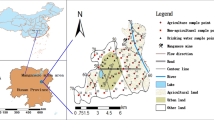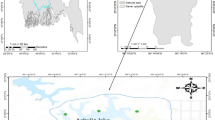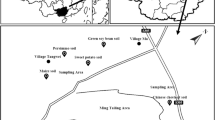Abstract
This study assessed metals in irrigation water, soil and potato crops impacted by mining discharges, as well as potential human health risk in the high desert near the historic mining center of Potosí, Bolivia. Metal concentrations were compared with international concentration limit guidelines. In addition, an ingested average daily dose and minimum risk level were used to determine the hazard quotient from potato consumption for adults and children. Irrigation water maximum concentrations of Cd, Pb and Zn in mining-impacted sites were elevated 20- to 1100-fold above international concentration limit guidelines. Agricultural soils contained total metal concentrations of As, Cd, Pb and Zn that exceeded concentration limits in agricultural soil guidelines by 22-, 9-, 3- and 12-fold, respectively. Potato tubers in mining-impacted sites had maximum concentrations of As, Cd, Pb and Zn that exceeded concentration limits in commercially sold vegetables by 9-, 10-, 16- and fourfold, respectively. Using conservative assumptions, hazard quotients (HQ) for potatoes alone were elevated for As, Cd and Pb among children (range 1.1–71.8), in nearly all of the mining-impacted areas; and for As and Cd among adults (range 1.2–34.2) in nearly all of the mining-impacted areas. Only one mining-impacted area had a Pb adult HQ for potatoes above 1 for adults. Toxic trace elements in a major regional dietary staple may be a greater concern than previously appreciated. Considering the multitude of other metal exposure routes in this region, it is likely that total HQ values for these metals may be substantially higher than our estimates.




Similar content being viewed by others
Abbreviations
- AMD:
-
Acid mine drainage
- MRL:
-
Minimal risk levels
- ATSDR:
-
Agency for Toxic Substances and Disease Registry
- HQ:
-
Hazard quotient
- EF:
-
Enrichment factor
- NOAEL:
-
No-observed-adverse-effect level
- ADD:
-
Average daily dose
- UNFAO:
-
Food and Agricultural Organization of the United Nations
References
Abbott, M. B., & Wolfe, A. P. (2003). Intensive pre-Incan metallurgy recorded by lake sediment from the Bolivian Andes. Science, 301(5641), 1893–1895.
Agency for toxic substances and disease registry (ATSDR). (2005). Public health assessment guidance manual (2005 Update). http://www.atsdr.cdc.gov/hac/phamanual/foreword.html.
Agency for toxic substances and disease registry (ATSDR). (2015). Toxicological profile information sheet. http://www.atsdr.cdc.gov/mrls/index.asp.
An, J., Jho, E. H., & Nam, K. (2015). Effect of soil dissolved humic acid on the Pb bioavailability in soil solution and its consequence on ecological risk. Journal of Hazardous Materials, 286, 236–241.
Archer, J., Hudson-Edwards, K. A., Preston, D. A., Howarth, R. J., & Linge, K. (2005). Aqueous exposure and uptake of arsenic by riverside communities affected by mining contamination in the Río Pilcomayo basin, Bolivia. Mineralogical Magazine, 69(5), 719–736.
Australia and New Zealand Environment and Conservation Council (ANZECC). (2000). Australian and New Zealand guidelines for fresh and marine water quality. http://www.environment.gov.au/system/files/resources/53cda9ea-7ec2-49d4-af29-d1dde09e96ef/files/nwqms-guidelines-4-vol1.pdf.
Ávila, P. F., Ferreira da Silva, E., & Candeias, C. Health risk assessment through consumption of vegetables rich in heavy metals: The case study of the surrounding villages from Panasqueira mine, Central Portugal. Environmental Geochemestry and Health (in Press).
Barbieri, F. L., Cournil, A., Souza, J. E., Bénéfice, E., & Gardon, J. (2011). Hair trace elements concentration to describe polymetallic mining waste exposure in Bolivian Altiplano. Biological Trace Element Research, 139(1), 10–23.
Bebbington, A., & Williams, M. (2008). Water and mining conflicts in Peru. Mountain Research and Development, 28(3/4), 190–195.
Bocangel, D. (2001). Small-scale mining in Bolivia: National study mining minerals and sustainable development. International Institute for Environment and Development. http://pubs.iied.org/pdfs/G00713.pdf.
Brandt, J. S., & Townsend, P. A. (2006). Land use—land cover conversion, regeneration and degradation in the high elevation Bolivian Andes. Landscape Ecology, 21(4), 607–623.
Budds, J., & Hinojosa, L. (2012). Restructuring and rescaling water governance in mining contexts: The co-production of waterscapes in Peru. Water Alternatives, 5(1), 119–137.
Cai, L., Xu, M. Z. C., Qi, J. Y., Feng, Z. Z., & Xiang, T. S. (2015). Assessment of exposure to heavy metals and health risks among residents near Tonglushan mine in Hubei, China. Chemosphere, 127, 127–135.
Carvalho, P. C. S., Neiva, A. M. R., Silva, M. M. V. G., & Santos, A. C. T. (2017). Human health risks in an old gold mining area with circumneutral drainage, central Portugal. Environmental Geochemistry and Health, 39(1), 43–62.
Center for Disease Control and Prevention (CDC). (2014). PB—What do parents need to know to protect their children? http://www.cdc.gov/nceh/lead/acclpp/blood_lead_levels.htm.
Cheyns, K., Peeters, S., Delcourt, D., & Smolders, E. (2012). Lead phytotoxicity in soils and nutrient solutions is related to lead induced phosphorus deficiency. Environmental Pollution, 164, 242–247.
Choque, C. P. (2007). Evaluación del grado de contaminación minera en las aguas de la microcuenca Villacollu Mayu. Tesis Magistral, Universidad Autónoma Tomás Frías. Potosí, Bolivia.
Cooke, C. A., Balcom, P. H., Kerfoot, C., Abbott, M. B., & Wolfe, A. P. (2011). Pre-Colombian mercury pollution associated with the smelting of argentiferous ores in the Bolivian Andes. Ambio, 40(1), 18–25.
Cooke, C. A., Mark, A. B., & Wolfe, A. P. (2008). Late-Holocene atmospheric lead deposition in the Peruvian and Bolivian Andes. Holocene, 18(2), 353–359.
Dandler, J., & Sage, C. (1985). What is happening to Andean Potatoes? A view from the Grass-roots. Development Dialogue, 1, 125–138.
Espi, E., Boutron, C. F., Hong, S., Pourchet, M., Ferrari, C., Shotyk, W., et al. (1997). Changing concentrations of Cu, Zn, Cd and Pb in a high altitude peat bog from Bolivia during the past three centuries. Water, Air, and Soil Pollution, 100(3), 289–296.
European Communities (EC). (2006). Commission regulation (EC) setting maximum levels for certain contaminants in foodstuffs. Official Journal of the European Union, 364, 5–24.
Farag, S., Das, R., Strosnider, W. H. J., & Wilson, R. T. (2015). Possible health effects of living in proximity to mining sites near Potosi, Bolivia. Occupational and Environmental Medicine, 27(5), 543–551.
Guzelian, P. S., Henry, C. J., & Olin, S. S. (1992). Similarities and differences between children and adults: Implications for risk assessment. Washington, DC: ILSI Press.
Hach Company. (2006). Digital Titrator Model 16900 Manual.
Helgesen, H., & Larsen, E. H. (1998). Bioavailability and speciation of arsenic in carrots grown in contaminated soil. Analyst, 123(5), 791–796.
Hellin, J., & Higman, S. (2005). Crop diversity and livelihood security in the Andes. Development in Practice, 15(2), 165–174.
Helwege, A. (2015). Challenges with resolving mining conflicts in Latin America. The Extractive Industries and Society, 2(1), 73–84.
Hudson-Edwards, K. A., Macklin, M. G., Miller, J. R., & Lechler, P. J. (2001). Sources, distribution and storage of heavy metals in the Rio Pilcomayo, Bolivia. Journal of Geochemical Exploration, 72(3), 229–250.
Hudson-Edwards, K. A., Miller, J. R., Preston, D., Lechler, P. J., Macklin, M. G., Miners, J. S., et al. (2003). Effects of heavy metal pollution in the Pilcomayo river system, Bolivia, on resident human populations. Journal de Physique IV, 107, 637–640.
Instituto Nacional de Estadística (INE). (2002). Censo Nacional de Población y Vivienda 2001. http://www.ine.gob.bo/default.aspx.
Instituto Nacional de Estadística (INE). (2011). Bolivia: Proyección de las esperanzas de vida al nacer por seo y periodos según región y departamento, 2000–2030. http://www.ine.gob.bo/indice/visualizador.aspx?ah=PC20131.HTM.
International Agency for Research on Cancer (IARC). (2006). Monographs on the evaluation of carcinogenic risks to humans: Inorganic and organic lead compounds (Vol. 87). Lyon: IARC.
International Agency for Research on Cancer (IARC). (2012). IARC monographs on the evaluation of carcinogenic risks to humans: Arsenic, metals, fibres and dusts (Vol. 100C). Lyon: IARC.
John, D. A., & Leventhal, J. S. (1995). Bioavailability of metals. Preliminary compilation of descriptive geoenvironmental mineral deposit models. USGS Open-File Report 95–0831. http://pubs.usgs.gov/of/1995/ofr-95-0831/CHAP2.pdf.
Kossoff, D., Hudson-Edwards, K. A., Dubbin, W. E., & Alfredsson, M. A. (2011). Incongruent weathering of Cd and Zn from mine tailings: A column leaching study. Chemical Geology, 281(1–2), 52–71.
Kossoff, D., Dubbin, W. E., Alfredsson, M. A., Edwards, S. J., Macklin, M. G., & Hudson-Edwards, K. A. (2014). Mine tailings dams: characteristics, failure, environmental impacts, and remediation. Applied Geochemistry, 51, 229–245.
Lim, H. S., Lee, J. S., Chon, H. T., & Sager, M. (2008). Heavy metal contamination and health risk assessment in the vicinity of the abandoned Songcheon Au–Ag mine in Korea. Journal of Geochemical Exploration, 96(2–3), 223–230.
Liu, W., Zhou, Q., Zhang, Y., & Wei, S. (2010). Lead accumulation in different Chinese cabbage cultivars and screening for pollution-safe cultivars. Journal of Environmental Management, 91(3), 781–788.
Lorenz, S. E., Hamon, R. E., Holm, P. E., Domingues, H. C., Sequeira, E. M., Christensen, T. H., et al. (1997). Cadmium and zinc in plants and soil solutions from contaminated soils. Plant and Soil, 189(1), 21–31.
Mazumder, G. D. N. (2003). Chronic arsenic toxicity: Clinical features, epidemiology, and treatment: Experience in West Bengal. Journal of Environmental Science and Health, Part A: Toxic/Hazardous Substances & Environmental Engineering, 38(1), 141–163.
McEwen, A. R., Hsu-Kim, H., Robins, N. A., Hagan, N. A., Halabi, S., Barras, O., et al. (2016). Residential metal contamination and potential health risks of exposure in adobe brick houses in Potosí, Bolivia. Science of the Total Environment, 562, 237–246.
McMahon, G., Evia, J. L., Pascó-Font, A., & Sánchez, J. M. (1999). An environmental study of artisanal, small, small, and medium mining in Bolivia, Chile, and Peru. World Bank Technical Paper No. 429, p. 66.
Tchobanoglous, G., & Burton, F.L. (1991). Wastewater engineering: Treatment, disposal and reuse (3rd ed.). NewYork: McGraw Hill.
Miller, J. R., Germanoski, D., Villaroel, L., & Lechler, P. (2009). Spatial and temporal variations in the transport and storage of trace metal contaminants in the upper Río Pilcomayo, Southern Bolivia. International Journal of Environmental Health, 3(4), 334–362.
Miller, J. R., Hudson-Edwards, K. A., Lechler, P. J., Preston, D., & Macklin, M. G. (2004). Heavy metal contamination of water, soil and produce within riverine communities of the Rio Pilcomayo basin, Bolivia. Science of the Total Environment, 320(2–3), 189–209.
Miller, J. R., Lechler, P. J., Mackin, G., Germanoski, D., & Villarroel, L. F. (2007). Evaluation of particle dispersal from mining and milling operations using lead isotopic fingerprinting techniques, Rio Pilcomayo Basin, Bolivia. Science of the Total Environment, 384(1–3), 355–373.
Moreno, E. J., Manzano, R., Esteban, E., & Peñalosa, J. (2010). The fate of arsenic in soils adjacent to an old mine site (Bustarviejo, Spain): Mobility and transfer to native flora. Journal of Soils and Sediments, 10(2), 301–312.
Mortensen, M. E., Wong, L. Y., & Osterloh, J. D. (2011). Smoking status and urine cadmium above levels associated with subclinical renal effects in U.S. adults without chronic kidney desease. International Journal of Hygene and Environmental Health, 214(4), 305–310.
Muñoz, M. A., Faz, A., Acosta, J. A., Martínez-Martínez, S., & Arocena, J. M. (2013). Metal content and environmental risk assessment around high-altitude mine sites. Environmental Earth Science, 69(1), 141–149.
Nelson, L. S., Lewin, N. A., Howland, M. A., Hoffman, R. S., Goldfrank, L. R., & Flomenbaum, N. E. (2011). Goldfrank’s toxicologic emergencies (9th ed.). NewYork: McGraw-Hill Companies Inc,
Neves, O., & Abreu, M. M. (2009). Are uranium-contaminated soil and irrigation water a risk for human vegetables consumers? A study case with Solanum tuberosum L., Phaseolus vulgaris L. and Lactuca sativa L. Ecotoxicology, 18(8), 1130–1136.
Oporto, C., Vandecasteele, C., & Smolders, E. (2007). Elevated cadmium concentrations in potato tubers due to irrigation with river water contaminated by mining in Potosí, Bolivia. Journal of Environmental Quality, 36(4), 1181–1186.
Oyarzún, J., Maturana, H., Paulo, A., & Pasieczna, A. (2003). Heavy metals in stream sediments from the Coquimbo Region (Chile): Effects of sustained mining and natural processes in a semi-arid Andean basin. Mine Water and the Environment, 22(3), 155–161.
Park, J. H., Bolan, N., Negharaj, M., & Naidu, R. (2011). Comparative value of phosphate sources on the immobilization of lead, and leaching of lead and phosphorous in lead contaminated soils. Science of the Total Environment, 409(4), 853–860.
Patrick, R., & Bharadwaj, L. (2016). Mining and campesino engagement: An opportunity for integrated water resources management in Ancash, Peru. Water International, 41(3), 468–482.
Rahman, I. M. N., & Hasan, M. T. (2007). Arsenic incorporation into garden vegetables irrigated with contaminated water. Journal of Applied Sciences and Environmental Management, 11(4), 104–112.
Rojas, C. J., & Vandecasteele, C. (2007). Influences of mining activities in the north of Potosí, Bolivia on the water quality of the Chayanta River, and its consequences. Environmental Monitoring and Assessment, 132(1–3), 321–330.
Salvarredy-Aranguren, M. M., Probst, A., Roulet, M., & Isaure, M. P. (2008). Contamination of surface waters by mining wastes in the Milluni Valley (Cordillera Real, Bolivia): Mineralogical and hydrological influences. Applied Geochemistry, 23(5), 1299–1324.
Smolders, A. J. P., Hiza, G., Van der Velde, G., & Roelofs, J. G. M. (2002). Dynamics of discharge, sediment transport, heavy metal pollution and sábalo (Prochilodus lineatus) catches in the Lower Pilcomayo River (Bolivia). River Research and Applications, 18(5), 415–427.
Smolders, A. J. P., Hudson-Edwards, K. A., Van der Velde, G., & Roelofs, J. G. M. (2004). Controls on water chemistry of the Pilcomayo river (Bolivia, South-America). Applied Geochemistry, 19(11), 1745–1758.
Smolders, A. J. P., Lock, R. A. C., Van der Velde, G., Medina, H. R. I., & Roelofs, J. G. M. (2003). Effects of mining activities on heavy metal concentrations in water, sediments, and macroinvertebrates in different reaches in the Pilcomayo River, South America. Archives of Environmental Contamination and Toxicology, 44(3), 314–323.
Stasinos, S., Nasopoulou, C., Tsikrika, C., & Zabetakis, I. (2014). The bioaccumulation and physiological effects of heavy metals in carrots, onions, and potatoes and dietary implications for Cr and Ni: A review. Journal of Food Science, 79(5), 765–780.
Stassen, M. J., Preeker, N. L., Ragas, A. M., Van de Ven, M. W., Smolders, A. J., & Roeleveld, N. (2012). Metal exposure and reproductive disorders in indigenous communities living along the Pilcomayo River, Bolivia. Science of the Total Environment, 427–428, 26–34.
Strosnider, W. H. J., Llanos López, F. S., LaBar, J. A., Palmer, K. J., & Nairn, R. W. (2014). Unabated acid mine drainage from Cerro Rico de Potosí, Bolivia: Uncommon constituents of concern impact the Rio Pilcomayo headwaters. Environmental Earth Sciences, 71(7), 3223–3234.
Strosnider, W. H. J., Llanos López, F. S., & Nairn, R. W. (2011a). Acid mine drainage at Cerro Rico de Potosí I: Unabated high-strength discharges reflect a five century legacy of mining. Environmental Earth Sciences, 64, 899–910.
Strosnider, W. H. J., Llanos López, F. S., & Nairn, R. W. (2011b). Acid mine drainage at Cerro Rico de Potosí II: Severe degradation of the Upper Rio Pilcomayo watershed. Environmental Earth Sciences, 64(4), 911–923.
Strosnider, W. H., Nairn, R. W., Rio Montero, H., & Llanos Pinto, F. (2011c). Water quality impacts from in-stream mine tailings in Rio Tarapaya, Potosí, Bolivia. In Proceedings of the American Society of Mining and Reclamation National Conference.
Thomas, D. J., Styblo, M., & Lin, S. (2001). The cellular metabolism and systemic toxicity of arsenic. Toxicology and Applied Pharmacology, 176(2), 127–144.
Uddh-Söderberg, T. E., Gunnarsson, S. J., Hogmalm, K. J., Lindegård, M. I., & Augustsson, A. L. (2015). An assessment of health risks associated with arsenic exposure via consumption of homegrown vegetables near contaminated glassworks sites. Science of the Total Environment, 536, 189–197.
U.S. Environmental Protection Agency (USEPA). (1993). Determination of inorganic anions by ion chromatography. USEPA method 300.0, Environmental Monitoring Systems Laboratory, Office of Research and Development.
U.S. Environmental Protection Agency (USEPA). (2006). Test methods for evaluating solid wastes, physical and chemical methods. USEPA SW-846, Office of Solid Waste, Washington, DC. http://www.epa.gov/epaoswer/hazwaste/test/sw846.htm.
Villarroel, L. F., Miller, J. R., Lechler, P. J., Germanoski, D., & Puch, E. (2007). Contaminación por metales pesados del sistema de drenaje Río Chilco-Río Tupiza, Sur de Bolivia. Ecología en Bolivia, 42(1), 48–71.
Watzlaf, G. R., Schroeder, K. T., Kleinmann, R. L. P., Kairies, C. L., & Nairn, R. W. (2004). The passive treatment of coal mine drainage. NETL, US Department of Energy, Pittsburg, PA.
World Health Organization (WHO). (1993). Evaluation of certain food additives and contaminants, Forty-First Report of the Joint FAO/WHO Expert Committee on Food Additives. Geneva. Technical Report Series No 837. http://apps.who.int/iris/bitstream/10665/36981/1/WHO_TRS_837.pdf.
Yang, Y., Zhang, F. S., Li, H. F., & Jiang, R. F. (2009). Accumulation of cadmium in the edible parts of six vegetable species grown in Cd-contaminated soils. Journal of Environmental Management, 90(2), 1117–1122.
Zeballos, H. H., Riveros, V. G., & Urdiniea, J. B. (2011). Seguridad Alimentaria en Bolivia. Fundacion Milenio. Coloquios Economicos No. 22. Konrad Adenauer Stiftung.
Acknowledgements
Funding and support was provided by the University of Oklahoma Presidential International Travel Fellowship, the Center for Restoration of Ecosystems and Watersheds at the University of Oklahoma, Saint Francis University Center for Watershed Research & Service, Clemson University Belle W. Baruch Institute of Coastal Ecology and Forest Science, Centro de Investigación Minero Ambiental (CIMA) and the Universidad Autónoma Tomas Frías (UATF). We thank Professors Freddy Llanos and Franz Mamani of UATF as well as Afnan Agramont and Ruben Mamani of Engineers In Action for critical support. We would also like to thank Dr. Vernon Chinchilli at Penn State University for his statistical analysis assistance.
Author information
Authors and Affiliations
Corresponding author
Rights and permissions
About this article
Cite this article
Garrido, A.E., Strosnider, W.H.J., Wilson, R.T. et al. Metal-contaminated potato crops and potential human health risk in Bolivian mining highlands. Environ Geochem Health 39, 681–700 (2017). https://doi.org/10.1007/s10653-017-9943-4
Received:
Accepted:
Published:
Issue Date:
DOI: https://doi.org/10.1007/s10653-017-9943-4




